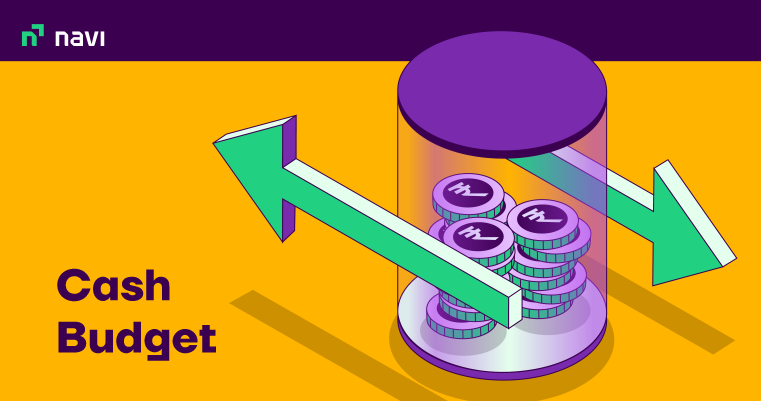Cash Budget Benefits, Functions And Importance Explained With Examples

A cash budget quantifies the cash flows of a business over a specified period. Preparing a proper cash budget allows a business to monitor the inflows and outflows of cash and ,thus, predict whether it will have sufficient funds to operate during a certain period.
Cash is called the lifeblood of a business, especially when it comes to smaller companies. That is why it is crucial for a business to monitor and report all expenses, gains and investments to control its finances.
What is Cash Budget?
A cash budget is a budget that quantifies cash inflows and outflows over a specific period. Cash receipts from debtors, dividends on shares, interest as loans, bill receipts, and other income from the sale of fixed assets are all sources of cash in this case.
A cash budget predicts a company’s future cash expectations during a given time. The position of cash can also be tracked on a monthly basis to assess the company’s financial performance.
The type of cash budget depends on the cash flow rate of the company. Businesses that see season fluctuations can create short-term budgets, while relatively stable businesses can create long-term budgets. In case of deficits of funds for future expenses, the company can plan additional financing to avoid hindrances in business.
Cash budgets only include inflow and outflow cash transactions. They exclude things such as credit sales and depreciation where no cash exchange is recorded.
Example of Cash Budget
Let us consider the following example of a one-month cash budget:
Let’s say, ABC Manufacturing Pvt. Ltd. has a cash balance of USD 20,000 at the start of the fiscal period. Sales of USD 10000, accounts receivable collections of USD 75000, and a fixed asset sale of USD 45000 is projected cash inflows for the month.
Adding all the amount, the resulting total cash is equal to USD 150,000. Now, its projected cash outflows include material payments of USD 25000, labour payments of USD 20000, selling expenses of USD 10000, printing expenses of USD 5000, repairs and maintenance activities of USD 10000, and asset purchases of USD 30000. As a result, the total outflow forecast is USD 100,000.
At the end of the budgeted period, the cash balance will be USD 50000 (USD 150000 – USD 100000). We can see that the closing cash balance with the company is greater than the opening balance.
The management may decide to use the surplus cash from the financing budget for the proposed activities. It may decide to pay dividends to its shareholders in the near future. Or it could just sit over it and use it later.
How Does a Cash Budget Function?
A cash budget consists of two sections – one for sources of cash and the other for uses of cash. The ‘source’ section lists the accounts receivables, initial cash balance, receipts from cash sales, etc. While the ‘uses’ section contains the budgets for direct material purchase, labour costs, manufacturing overhead and administrative costs.
The following is a list of the functions of a cash budget for a company:
1. Prediction of Cash Requirements
Cash budgets are useful for predicting cash requirements for a particular period. This helps in planning necessary expenditures for that time.
2. Cash Position Indication
Cash budgets indicate a company’s financial position at a particular time. It shows whether there’s a cash deficit or surplus in the financials. This helps a firm in planning to borrow or invest cash.
3. Keeping Finances in Check
Once departmental budgets are set, they are hard to change. Hence, departments work with the resources they have available to them.
4. Help in Expansion Plans
When institutions have a surplus of resources, they often plan for the expansion of their projects or infrastructure. A cash budget is helpful for formulating such plans.
5. Proper Dividend Policies
Good dividend policies depend upon cash budgets. Investors are encouraged by a company offering cash dividends, as a higher dividend payout shows a better financial situation for the company.
Also Read
Importance of Cash Budget
1. Beneficial in Proper Planning
Having a cash budget helps company management make sound strategic choices. The company or organisation would be aware of any potential cash surplus or deficit scenario in the near future. In both cases, it is possible to plan ahead of time to avoid an unexpected crisis or the setback of an investment opportunity.
A cash deficit, on the other hand, can serve as a warning to cut back on spending. It can also arrange funds timely through equity or debt.
2. Helpful in Dealing with Seasonal Variations
A cash budget may be desirable in the long run. However, due to the seasonal nature of businesses, they may still show cash deficits in certain months or periods. Management can carefully plan how to deal with seasonal variations ahead of time. For periods of stress or low sales, proposed cash outflows can be curtailed or avoided in a timely manner. It will aid the company in avoiding a cash deficit.
Furthermore, managers can anticipate periods with a cash surplus. Sitting on idle cash can result in the loss of an investment opportunity. It may result in the company losing out on substantial profits.
3. Increasing the Value of the Brand
A cash budget is a tool for adequately timing the company’s expenditures based on its cash resources. As previously stated, it also allows management time to prepare for using surplus cash when it becomes available. In addition, it aids in the timely payment of materials to suppliers, early debt repayment, timely salary disbursement, proper streamlining of production activities to ensure timely customer deliveries, and so on. As a result, the company’s goodwill and brand value grow. This, in turn, aids the company’s revenues and profits.
Benefits of Cash Budget
The cash budget has the following advantages:
- Provides information on varying cash receipts and usage sources
- Provides information on potential future inflows and outflows
- Includes information on excess requirements of cash
- Includes information on how to acquire deficit cash
- Beneficial for contingencies where cash balances are low, as well as in demonstrating ways to fill such gaps
- Ensures that timely payments are being made
- Provides investment of surplus funds for more profit
- Allows for the planning of both short-term as well as long-term loan repayments
- Provides for the establishment of a contingency cash pool to control unplanned outflows of cash
How to Create a Cash Budget
There are a few simple steps one can follow to create a cash budget for his or her business. These are:
Step 1: Use a specialised accounting tool or MS Excel to create a cash budget template
Step 2: Assess the time frame suitable for your business’s cash budget. It should not be more than a year since long future predictions are often inaccurate. Also, determine whether it’s more suitable to budget on a monthly or quarterly basis
Step 3: Keep aside an emergency fund for at least 3 months
Step 4: Enter the business’s current cash balance since this is the only certain amount. If you are a sole proprietor, enter the amount you have set aside for future business expenditure
Step 5: Create a monthly cash flow statement and analyse business expenditure and money collection
Step 6: Forecast the business’s cash flow. Start by estimating the inflows and the outflow cash payments. This will help in projecting the cash flow
Difference Between Cash Budget and Working Capital Budget
The critical distinctions between a working capital budget and a cash budget are as follows:
| Cash Budget | Working Capital Budget |
| It is designed to meet the basic needs of the business, along with funds for fixed capital acquisition | It establishes estimations for the business’s capital requirements for the current session |
| Such budgets are planned for shorter periods | Working capital budgets are planned for more extended periods |
| Capital expenses are considered in a capital budget | Non-capital expenses are considered in a working capital budget |
Final Word
Cash budget helps estimate the cash flows presented in a cash budget that allows businesses to plan for future cash availability. Financial plans are developed to account for periods of high and low cash balances. Massive cash balances indicate that the company did not earn the best rate of return. Due to insufficient cash reserves, the company will be unable to pay its bills. Businesses should maintain an adequate cash balance to meet their projected cash needs and additional reserves to cover unforeseen contingencies.
FAQs
Ans: A business owner or accountant should update the company’s cash budget depending on the cash currently available. Updating the cash budget on a monthly or quarterly basis is a wise choice. It is good to update it quarterly if your business has enough cash to cover the quarter.
Ans: It is usually the head of finances of a company who creates the cash budget. This could be the Chief Financial Officer, Controller or any Senior Accountant.
Ans: Cash budgets usually consist of four elements which are: cash receipts, cash disbursements, the net change in cash and new financing needs.
Disclaimer
This article is solely for educational purposes. Navi doesn't take any responsibility for the information or claims made in the blog.
Personal Loan in Your City

Customer’s Feedback
No comments found.10 Best Bank for Savings Account in India [Highest Interest Rate 2023]
Savings account is a type of financial instrument offered by several banks. It lets you safely depo... Read More »What is Issuer Identification Number (IIN)- Working and Importance
What is an Issuer Identification Number (IIN)? Banks and financial institutions assign a distinc... Read More »What is a Vostro Account – Meaning, Working and Difference
What is a Vostro Account? A Vostro account is a bank account held by a domestic bank on behalf o... Read More »What is a Solvency Certificate? – Format, Documents Required & How to Apply Online?
What is a Solvency Certificate? A solvency certificate is a legal document furnishing the detail... Read More »What is Merchant Banking – Services, Features, Functions and Example
What is Merchant Banking? Merchant banking is a set of select banking and financial services off... Read More »Automated Clearing House: Objectives, Types and Process
Automated Clearing House is an electronic fund transfer network that manages automatic and direct... Read More »How to Redeem Credit Card Reward Points ?
Credit Card Reward points are types of incentives that customers receive when they use a credit car... Read More »What is Electronic Clearing Service (ECS) in Banking and How does it Work?
What is Electronic Clearing Service (ECS)? Electronic Clearing Service (ECS) is a method of elec... Read More »What are Credit Card Validators and How to Use them?
What is a Credit Card Validator? A credit card validator is a tool that checks the validity of a... Read More »What is Cash Management and How Does it Work?
Managing available capital can make sure that a small business stays afloat. Cash management is an ... Read More »What are Prepaid Expenses? – Definition, Examples, and Journal Entry
Prepaid expenses represent payments made in advance for products or services expected to be incurre... Read More »Increase Credit Card Limit – Important Tips and How to Do It?
The credit card limit is the maximum amount of money you can spend using your credit card. Your cre... Read More »Top 10 Chit Fund Schemes in India in 2023
Chit funds are one of the most popular return-generating saving schemes in India. It is a financial... Read More »10 Best Gold ETFs in India to Invest in April 2023
Gold ETFs or Gold Exchange Traded Funds are passively managed funds that track the price of physica... Read More »10 Best Demat Accounts in India for Beginners in 2023
Creation of Demat accounts revolutionised the way trades were conducted at the stock exchanges. It... Read More »20 Best Index Funds to Invest in India in April 2023
What is an Index Fund? An index fund is a type of mutual fund or exchange-traded fund (ETF) that... Read More »Best Arbitrage Mutual Funds to Invest in India in April 2023
Arbitrage funds are hybrid mutual fund schemes that aim to make low-risk profits by buying and sell... Read More »10 Best SIP Plans in India to Invest in April 2023
What is SIP? SIP or Systematic Investment Plan is a method of investing a fixed amount in ... Read More »10 Best Corporate Bond Funds in India to Invest in April 2023
Corporate bond funds are debt funds that invest at least 80% of the investment corpus in companies ... Read More »10 Best Bank for Savings Account in India [Highest Interest Rate 2023]
Savings account is a type of financial instrument offered by several banks. It lets you safely depo... Read More »































